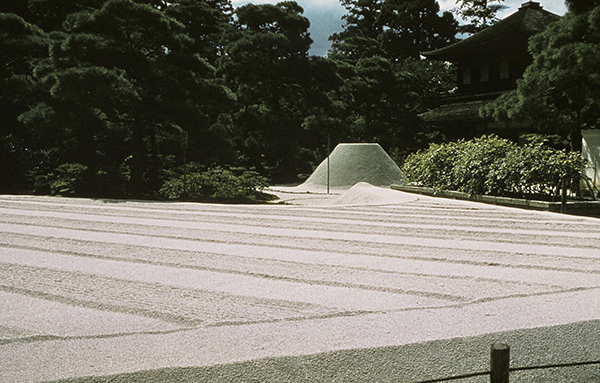World Landscape Architecture Month: Ginkakuji Temple
Landscape architects around the world make works of art out of the natural environment. Every culture has aesthetics that guide this work. In the case of traditional dry gardens in Japan, Zen Buddhist austerity, simplicity, and subtlety inspired designers.
 |
| Ashikaga Yoshimasa (1436–1490, Japan), Sea of Silver Sand (Ginshaden) with Moon Viewing Platform (Kogetsu-dai), Ginkakuji Temple (Jishō-ji Temple), Kyoto, 1482–1493. Image © 2023 Davis Art Images (8S-10280) |
Gardens of sand, gravel, and rocks were meant entirely for contemplation. In the spirit of Zen simplicity, such gardens reflect the essence of black-and-white ink painting landscapes. The garden is meant to be viewed from various sides, a sort of landscape painting in the round. At the Zen temple Ginkakuji (“Silver Pavilion”) in Kyoto, the garden was designed for viewing the autumn moon. In front of the main hall are large sand mounds—the Sea of Silver Sand (Ginshaden) and the Moon Viewing Platform (Kogetsu-dai)—intended to accentuate the beauty of the moon's light falling on them.
The Ashikaga shogun Yoshimasa built a pavilion at Ginkakuji that was to be his retirement retreat. Yoshimasa was lackluster as a shogun, unable to quell the civil wars that began between samurai families for control of Japan. When Yoshimasa named his brother’s son as his successor, he retired to Ginkakuji, designing both his pavilion and the gardens surrounding it. Respected for refinement in the disciplines of the tea ceremony, noh theater, poetry, calligraphy, and, of course, garden design, Yoshimasa's aesthetic was based largely on the ideals of Zen Buddhism and the concept of wabi-sabi (beauty in simplicity). According to Yoshimasa's wishes, the villa was converted to a temple on his death, which was officially named Jishō-ji (“Temple of Shining Mercy”).
During the Kamakura period (1185–1333)—Japan’s so-called “medieval” period—the provincial military families fought one another for control of the country. The Gempei Wars (1185–1192) witnessed the victory of the samurai-supported clans over the emperor’s court, as well as the institution of the shogunate, a military dictatorship that would rule Japan until the 1800s. The respected emperor no longer had any real power. Samurai families cemented their power over Japan during the Muromachi period (1392–1573).
From the Kamakura to the Muromachi periods, Zen Buddhism took a strong hold in Japanese religion. It was particularly favored by the samurai class because they lived without fear of death, acting spontaneously and intuitively. One of the overriding themes in Zen Buddhism is the experience of enlightenment when one least expects it. Meditation on the simple things in life encouraged preparing one for such an experience.
Zen Buddhism had a great influence on architecture from the Kamakura through the Edo period. The elaborate, overdecorated style of Chinese temple architecture was rapidly overtaken by the influence of earlier simple, light, and serene Japanese styles. A significant part of temples from the Kamakura period until the 1800s was an emphasis on the contemplation of gardens, landscape, and the moon, as well as the tea ceremony. The garden was an integral part of temple architecture.
Correlations to Davis programs: The Visual Experience 4E: 11.5; A Personal Journey 2E: 5.1; Explorations in Art 2E Grade 3: 4.8; Explorations in Art 2E Grade 6: 4.8; Exploring Visual Design 4E: Chapter 11


Comments